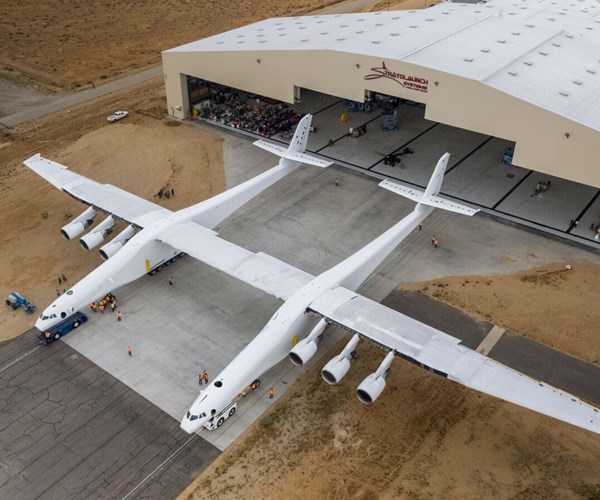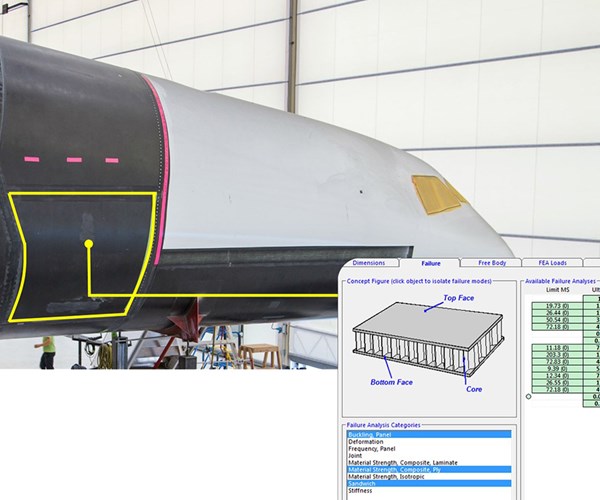Optimizing composites for the Stratolaunch
Stratolaunch represents an unprecedented use of composites in an aircraft. Optimizing the design of composites for the launcher was a daunting challenge.

Stratolaunch rollout, spring 2017.
When the massive, composites-intensive Stratolaunch aircraft rolled out of the Mojave, CA, US, Air and Space Port hangar in spring 2017 in preparation for ground testing, it was a clear example of how far the design and manufacture of composite materials have progressed in recent years. In September, the first phase of engine testing on the aircraft’s six Pratt & Whitney turbofan engines was completed.
Stratolaunch, the world’s largest aircraft by wingspan (wider than a football field is long), is almost entirely fabricated from composite materials and, according to Stratolaunch, represents the largest application of composites in an aircraft.
The Stratolaunch aircraft is the brainchild of Stratolaunch System Corp. founder Paul G. Allen. It has two fuselages connected by a giant single wing and is powered by six engines that will enable it to take off from a runway carrying a payload of up to 550,000 lb. At the cruising altitude of a commercial airliner, the Stratolaunch air-launch platform will release the space launch vehicle payload and return to the airport for reuse. The first launch demonstration is anticipated to take place as early as 2019.
Collier Research Corp.’s (Newport News, VA, US) HyperSizer optimization software was used extensively by Stratolaunch manufacturer Scaled Composites (Mojave, CA, US) to optimize the aircraft's composite fuselage and wing structure. HyperSizer, the first software package to be commercialized out of NASA, has been deployed on a variety of aerospace and other industry projects fabricated with composite or metallic materials. The software automatically performs design, stress analysis and sizing optimization, typically reducing the weight of structures by 20-40%.

HyperSizer applied to Stratolaunch.
“To ensure the most efficient use of materials in an all-composite structure of any size requires effective employment of design and manufacturing optimization tools from the very earliest stages,” says Collier Research president Craig Collier.
For the massive Stratolaunch wing, deflection limits were a significant factor to be taken into account. The panels of the duel fuselages were sized for strength, stability and honeycomb sandwich failure modes. By using HyperSizer, the stress team had access to a comprehensive set of automated failure analyses that includes rapid free-body analysis, discrete laminate sizing, ply-based composite failure analysis, honeycomb sandwich analysis methods such as wrinkling, core shear, flatwise tension and intracell dimpling and scripting application program interface (API) to push in loads from Excel spreadsheets.
Collier is seeing continuing evolution in the integration of the toolsets used for composites design and manufacturing. “HyperSizer software can provide insight into how producible a structure is and whether there might be any manufacturing issues,” says Craig Collier. “It can incorporate laminate fabrication preferences in early-stage design thought; ease-of-manufacturing is becoming a major influence with strength design-of-laminate structures.”
Related Content
-
Automated robotic NDT enhances capabilities for composites
Kineco Kaman Composites India uses a bespoke Fill Accubot ultrasonic testing system to boost inspection efficiency and productivity.
-
ASCEND program update: Designing next-gen, high-rate auto and aerospace composites
GKN Aerospace, McLaren Automotive and U.K.-based partners share goals and progress aiming at high-rate, Industry 4.0-enabled, sustainable materials and processes.
-
Composite sidewall cover expands options for fire-safe rail components
R&D project by CG Rail explores use of carbon fiber-reinforced thermoplastics and recycled manufacturing scrap to meet fire safety, weight and volume targets.
















